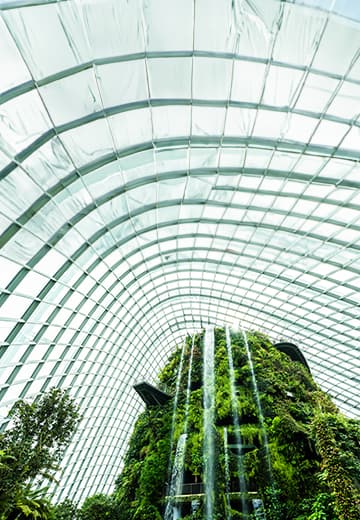In today's world, more and more buyers are opting for eco-friendly materials. The construction industry, influenced by globalization, is striving to reduce environmental pollution.
According to the UN Environment Program, buildings and reinforced concrete structures are responsible for approximately 37% of global carbon dioxide (CO2) emissions from energy and construction processes. This is due to the industry's heavy reliance on fossil fuels, including high-carbon materials such as concrete, steel and glass, as well as greenhouse gases emitted during heating and cooling of buildings.
The market for primary and deep processing of the fiber part of hemp plants is rapidly developing in the United States. The plant will generate significant volumes of raw materials for the production of biofuels, composite materials, and light industry. However, we are interested above all in the possibility of its use in the construction industry.
Some US states are taking tough measures against the construction industry and materials that involve high carbon emissions during construction or production of structural materials. For example, California passed a law requiring the reduction of the carbon footprint of new buildings by 40% by 2045. The states of New York and New Jersey have also adopted the regulations for greenhouse gas emission reduction for new buildings, as have the cities of New York or York, Pennsylvania.
Building materials made from hemp can absorb tons of carbon from inside the constructed building, adjusting the amount of greenhouse gases to low or even zero levels. Carbon credits and rebates can also play a role in making hemb buildings more attractive and financially affordable for both consumers and construction companies. Therefore, some US municipal programs aim to use hemp raw materials for the production of building materials to reduce CO2 emissions.
One of the materials used in the construction industry is bast concrete, which is made from lime mixed with bast (bast is the core of the stem, which is lignified and hard, but at the same time light and very porous) and water.
During the primary processing of the fibrous part of the hemp plant, the yield of bast is 50 to 70%, with about 20% of long fibers (used primarily for the production of textiles, knitted and twisted products) and short technical fibers, which are mainly used to make nonwovens. About 8% of the primary processing products are dust or microfibers, which are effectively used for plasters, putties or other construction mixtures.
Hemp fibers have been actively used in Europe for the manufacture of insulation materials for the past 30 years. Therefore, the different values of hemp insulation materials, thermal mass, fire resistance and mold resistance have already been tested and determined, which will reduce the time for approval of building codes regulating the requirements for building materials.
Firebrick is widely used as an exterior natural insulation material applied over wood, steel or concrete. Mario Machnicki, president of American Lime technology, a company specializing in the construction of buildings and structures using fire-aged concrete, says that hemp-based building materials can currently cost slightly more than traditional building materials. This is due to the fact that until recently, hemp had to be imported from abroad. "When we started our construction business 12 years ago, we had to import all the hemp components from the UK, which significantly increased the final cost of the product. As the US market for industrial hemp grows, the cost of building materials that use properties of the plant will rapidly decrease."
This year, American companies producing hemp blocks are scheduled to open in Colorado (Hemp and Block and Hemp Building Company), Washington (Earth Merchant), Indiana (GaiaBloc), and California (DTE Materials). Most likely, several international companies producing hemp blocks will appear in the United States. For example, the Canadian company DiVita Blocks is trying to enter the market of product sales in California, South Carolina, and several other US states. European companies are sizing up the US hemp block market, such as the French company HempBLOCK International and the Belgian block manufacturer IsoHemp.
Eco-friendly building materials
CHIPBOARD
Hemp-based chipboard blended with other fibers such as flax is lighter, stronger and more resistant to moisture than its traditional analogue. The material in standard particleboard is often bonded together with formaldehyde-based adhesives that emit gas over the life of the product. Since these adhesives cannot be used with hemp chipboard, it means a safer product, as formaldehyde is a suspected carcinogen.
Although it is not yet widely available and is more expensive compared to standard chipboard, this is expected to change as more companies start producing the product. While traditional chipboard is often made from wood waste, supply issues have led to trees being specifically cut down for chipboard materials.
Hemp insulation
Insulation made from industrial hemp fibers is available in a variety of forms, including batts, rolls, and solid panels. Batt contains a small percentage of polypropylene or polyethylene to bind the hemp instead of chemicals. Hemp insulation does not rot, helps control humidity and is pest resistant. Another advantage is that there is no need for personal protective equipment used when laying conventional insulation products, although a mask is recommended to avoid inhaling dust. When used as an insulation material, hemp provides high heat resistance and excellent sound absorption properties. Furthermore, it can absorb a significant amount of moisture without any deterioration in its thermal performance.
Plaster
Limestone plaster or hemp-based cladding, like hemp concrete (hempcrete), is easy to use and simply applied in a thinner layer.
It adds an extra layer of thermal and sound insulation to existing walls. One of the advantages over conventional limestone plasters is the ability to apply a thicker layer.
This is a product that can really stand the test of time. Hemp-based limestone plaster has preserved caves in India that have been completely exposed to the natural elements for 1,500 years.
Examples of buildings constructed using industrial hemp
Case di Luce, a residential complex with a concrete frame and hemp roof in Bisceglie, Italy.
CASE DI LUCE is a high-tech, innovative sustainable urban regeneration project in the city of Bisceglie. The project envisages replacing abandoned urban industrial facilities that create significant environmental problems with a new highly efficient and energy self-sufficient urban model. It includes an eco-park and facilities that, while preserving the bioclimatic and morphological features of the area, interact in a spatial and temporal unicum. The project consists of two multi-storey residential and commercial buildings with energy efficiency class A+ and 61 apartments.
For the construction of the building, Studio Pedone chose natural and environmentally compatible materials such as tuff, lime and hemp. Solutions aim to guarantee adequate thermal and sound insulation using certified breathable natural materials with low or no volatile pollutant emissions (CO2). Considering the social component as well as the environmental friendliness of such a house, the project was granted a state subsidy of up to 11% of its total cost of €1.66 million.
Casa di Luce by Pedone Studio in Bisceglie is an excellent example of bioclimatic construction with modern appeal.
The French architecture company Lemoal Lemoal in Croissy-Beaubourg near Paris has built the country's first public building entirely made of a mixture of hemp, lime and water. The Pierre Chevet Sports Center has an area of 380 square meters and is used as a fitness room for visitors engaged in basic or specialized training.
The structural design principle was based on the desire to use durable materials with different characteristics. Wooden semi-vaulted porticos, which free up maximum space for sports, rest on a wall of hemp blocks for support. These hemp concrete blocks were chosen for their numerous qualities that enhance comfort and safety, including high thermal, acoustic and structural performance and fire resistance.
The walls of the building are made of fire-retardant concrete and lined with fiber cement panels to protect the hemp building blocks from external aggressive environments. The hemp raw material was grown and processed within dozens of kilometers from the firebrick producer.
The raw materials for the fire-retardant concrete were collected less than 500 km from the project site.
The staff at Lemoal Lemoal Studio claim that the main challenge of using cannabis building materials is to convince customers that it is a viable alternative to concrete, because a fire-concrete wall looks a little more wooden and not as insulated as concrete. And despite the fact that now fire-concrete is more expensive than traditional building mixes, due to its insulating properties, it is extremely efficient in the long run because of lower utility costs, which after a short period of time compensate for "its initial high cost."
Ukrainian example
The Ukrainian company Hempire, which has been operating in the Ukrainian market since 2015 and specializes in the construction of hempy eco-houses throughout Eastern Europe, on its official Facebook page announced the plans to implement an ambitious project to build the largest residential hemp project in Ukraine.
"This will be our most ambitious residential hemp project in Ukraine! We are very happy that we have chosen hemp filler as the walls! And this is just the beginning! Glory to Ukraine! Glory to the Armed Forces! Glory to hemp!" the statement reads.
According to the plan, the area of the new building will be 900 m². It will be a center for IDPs and orphans.
The founder of Hempire, Serhii Kovalenko, graduated from Carleton University in Ottawa with a degree in Civil Engineering. He has managed construction projects in Canada, the United States, and Switzerland. He got acquainted with the technology of building eco-houses in Australia, where he was engaged in the construction of residential buildings.
The building material based on industrial hemp follows any shape and dries quickly. In a year, hemp gives an increase in plant mass of more than 50-year-old forest, actively absorbing carbon dioxide. One hectare of hemp can absorb up to 10 tons of CO2 from the atmosphere during the growth period.
Hempire has created a building material called Hempire-mix, which is designed to insulate rooms or as an alternative to concrete and brick in construction. It is made from chopped industrial hemp stalks mixed with water and lime binder and does not contain toxic additives.
Hempire-mix is distinguished by its binding component, which does not require the use of cement. This not only helps to preserve the environment, but also increases the energy efficiency of the material. The use of such insulation can reduce heating and air conditioning costs, as it effectively regulates humidity, retains and gradually releases heat. In addition, Hempire-mix perfectly insulates sounds, and the high alkalinity due to the presence of lime prevents the appearance of rodents and fungal infections.
This project, funded by Spanish donors from abroad, is being implemented on the territory of the Stryi community.
According to the plan, the building is designed for 180 people. It is intended to accommodate IDPs and orphans. The walls and roof will be insulated with Hempire-mix material.
At BDO in Ukraine, we are ready to provide advice on the development of green technologies in your company. Our Construction and Real Estate industry group is always at the forefront of technological change, innovation and the preservation of green technologies in construction.




